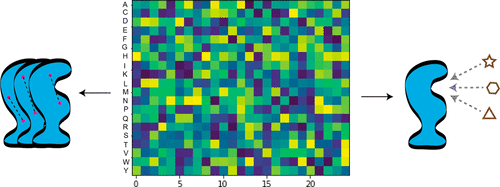当前位置:
X-MOL 学术
›
Biochemistry
›
论文详情
Our official English website, www.x-mol.net, welcomes your feedback! (Note: you will need to create a separate account there.)
Systems Approaches to Understanding and Designing Allosteric Proteins
Biochemistry ( IF 2.9 ) Pub Date : 2018-01-08 00:00:00 , DOI: 10.1021/acs.biochem.7b01094 Srivatsan Raman 1
Biochemistry ( IF 2.9 ) Pub Date : 2018-01-08 00:00:00 , DOI: 10.1021/acs.biochem.7b01094 Srivatsan Raman 1
Affiliation

|
The study of allostery has a central place in biology because of the myriad roles of allosteric proteins in cellular function. As technologies for probing the spatiotemporal resolution of biomolecules have become increasingly sophisticated, so has our understanding of the diverse structural and molecular mechanisms of allosteric proteins. Studies have shown that the allosteric signal is transmitted a through a network of residue–residue interactions connecting distal sites on a protein. Linking structural and dynamical changes to the functional role of individual residues will give a more complete molecular view of allostery. In this work, we highlight new mutational technologies that enable a systems-level, quantitative description of allostery that dissect the role of individual residues through large-scale functional screens. A molecular model for predicting allosteric hot spots can be developed by applying statistical tools on the resulting large sequence–structure–function data sets. Design of allosteric proteins with new function is essential for engineering biological systems. Previous design efforts demonstrate that the allosteric network is a powerful functional constraint in the design of novel or enhanced allosteric proteins. We discuss how a priori knowledge of an allosteric network could improve rational design by facilitating better navigation of the design space. Understanding the molecular “rules” governing allostery would elucidate the molecular basis of dysfunction in disease-associated allosteric proteins, provide a means for designing tailored therapeutics, and enable the design of new sensors and enzymes for synthetic biology.
中文翻译:

理解和设计变构蛋白的系统方法
由于变构蛋白在细胞功能中的多种作用,因此变构研究在生物学中具有中心地位。随着用于探测生物分子的时空分辨率的技术变得越来越复杂,我们对变构蛋白的不同结构和分子机理的理解也越来越多。研究表明,变构信号通过连接蛋白质末端的残基-残基相互作用网络传输。将结构和动力学变化与单个残基的功能作用联系起来,将提供更完整的变构分子观察。在这项工作中,我们重点介绍了新的突变技术,这些技术可以对变构进行系统级的定量描述,从而可以通过大规模功能筛选来剖析单个残基的作用。通过对所得的大序列,结构,功能数据集应用统计工具,可以开发出预测变构热点的分子模型。设计具有新功能的变构蛋白质对于工程生物系统至关重要。先前的设计工作表明,变构网络是新颖或增强的变构蛋白设计中的强大功能约束。我们讨论如何变构网络的先验知识可以通过促进设计空间的更好导航来改善合理设计。了解控制变构的分子“规则”将阐明与疾病相关的变构蛋白质中功能障碍的分子基础,为设计量身定制的治疗方法提供手段,并为合成生物学设计新的传感器和酶。
更新日期:2018-01-08
中文翻译:

理解和设计变构蛋白的系统方法
由于变构蛋白在细胞功能中的多种作用,因此变构研究在生物学中具有中心地位。随着用于探测生物分子的时空分辨率的技术变得越来越复杂,我们对变构蛋白的不同结构和分子机理的理解也越来越多。研究表明,变构信号通过连接蛋白质末端的残基-残基相互作用网络传输。将结构和动力学变化与单个残基的功能作用联系起来,将提供更完整的变构分子观察。在这项工作中,我们重点介绍了新的突变技术,这些技术可以对变构进行系统级的定量描述,从而可以通过大规模功能筛选来剖析单个残基的作用。通过对所得的大序列,结构,功能数据集应用统计工具,可以开发出预测变构热点的分子模型。设计具有新功能的变构蛋白质对于工程生物系统至关重要。先前的设计工作表明,变构网络是新颖或增强的变构蛋白设计中的强大功能约束。我们讨论如何变构网络的先验知识可以通过促进设计空间的更好导航来改善合理设计。了解控制变构的分子“规则”将阐明与疾病相关的变构蛋白质中功能障碍的分子基础,为设计量身定制的治疗方法提供手段,并为合成生物学设计新的传感器和酶。



























 京公网安备 11010802027423号
京公网安备 11010802027423号